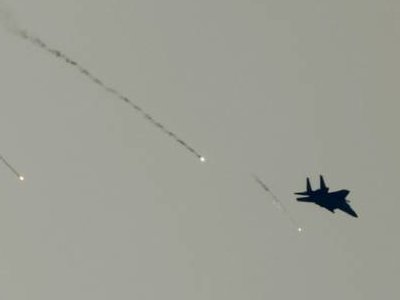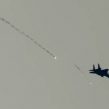
RUSSIA OFFERS GEORGIA A STICK AND A CARROT
Publication: Eurasia Daily Monitor Volume: 5 Issue: 78
By:

On Sunday, April 20, an unarmed Georgian reconnaissance drone was shot down over the territory Abkhazia. The Georgian authorities alleged that a Russian Air Force MiG-29 fighter had downed the drone. The jet, according to Georgian radar data, took off from an airbase near Gudauta in Abkhazia and, after destroying the drone, flew north over the border and the Caucasian mountains into Russian territory. The Georgians released a video they say was recorded and transmitted by the camera of the drone just before it was hit by an air-to-air missile. The video shows a distinct silhouette of a twin-tailed fighter with no visible markings firing a missile.
The Russian military have vigorously denied any involvement and have called the Georgian accusations “fantasies,” while maintaining that the Abkhaz military shot down the drone. The Abkhaz Deputy Defense Minister Garry Kupala told journalists that an Abkhaz Air Force L-39 jet had flown the mission, not a Russian MiG-29. Kupala said that the collected debris of the drone indicated that it was an Israeli-made Hermes-450. Last month a similar drone was shot down over Abkhazia (RIA-Novosti, Interfax, www.newsru.com, April 21, 22).
The L-39 Albatros is an old two-seater Czech-made trainer jet used by the Russian Air Force to teach cadets basic flying skills. The fighter in the Georgian video does not resemble an L-39, which has a distinctive silhouette with a single tail. The L-39 is an unarmed plane but can carry two small bombs under its wings and may be used as a light bomber. The L-39 has no on-board radar or any equipment to fire air-to-air missiles. A successful interception by an L-39 of a small drone in the skies over Abkhazia is not a plausible story.
In the war in 1992-1993 in Abkhazia, Chechen separatists as well as the Russian military supported the Abkhaz against the Georgians. The Abkhaz leaders at the time claimed that the late Chechen separatist leader Dzohar Dudayev gave them several L-39s from the stock of a former Russian flying school in Hankala near Grozny. The jets were used to bomb Georgian positions. The Abkhaz showed this Jamestown correspondent a stretch of a highway south of Gudauta that they used as an improvised airstrip. In fact, Russian military aircraft from the Gudauta airbase attacked the Georgians. In 1994 at that airbase, a Russian pilot related a story of how he had flown sorties to bomb the Georgians and how the crews masked the red stars of their Air Force plane identifications before take-off.
The same may have happened last Sunday. Last year Georgia accused Russia of a helicopter gunship attack in March in the Kodori Gorge and of another attack by a Russian jet with an air-to-ground missile in August near South Ossetia. In both cases the Russian military strenuously denied any involvement. The Russian authorities have declared that Russian forces have abandoned the Gudauta airbase, but no foreign observers have been allowed to verify this claim.
At a press conference in Moscow last October the Abkhaz leader Sergei Bagapsh told journalists that reconnaissance drones were regularly flying over Abkhazia, and he threatened to have them shot down (ITAR-TASS, October 5, 2007). Until this week, Georgia did not openly disclose that it had drones. Last November in Tbilisi, Foreign Minister Gela Bezhuashvili told Jamestown that Georgia had acquired Israeli-made drones. A day later President Mikheil Saakashvili refused to comment. Now Saakashvili has announced that Georgia has some 40 Israeli-made drones that are used to monitor Abkhaz troop movements. Saakashvili declared that Russia had secretly expanded military aid to Abkhazia and had deployed military aircraft in the region. On April 21 Saakashvili phoned President Vladimir Putin, but the talks do not seem to have reduced tension (New York Times, April 22).
Last week Putin issued an executive order (poruchenyie), authorizing the “improvement of relations” between Russian government agencies and the authorities in Abkhazia and South Ossetia. This decision has been seen in Abkhazia, South Ossetia, and in Russia as an important step toward eventual official recognition of the separatist regimes, while in Georgia it was denounced as “creeping annexation” (www.newsru.com, April 16; EDM, April 18). At the same time, Moscow has been partially dismantling sanctions it imposed on Georgia in 2006. Direct passenger flights have resumed between Moscow and Tbilisi, as well as postal services and money transfers. Russian officials have indicated that in the future Georgian wine and mineral water imports maybe allowed.
Moscow’s overall strategy seems to be aimed at changing Georgian pro-Western policies by a combination of pressure and offers of perks. Russia has demonstrated that it can shoot down planes, bomb from time to time and openly support separatists and there is nothing much the West or the Georgians can do. But if the Georgians “come to their senses” (odumayutsia) and refuse to join NATO, they will be rewarded. At present, the Kremlin does not seem to intend to actually annex Abkhazia or South Ossetia. A future clash in the Kodori Gorge in Abkhazia or in South Ossetia may escalate at any time into an all-out war even though no one seems to want it.




